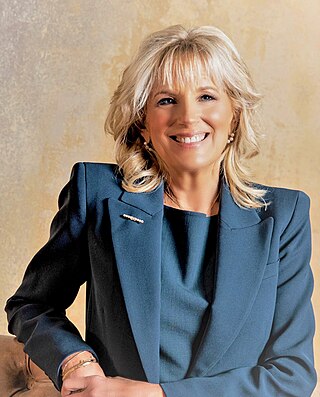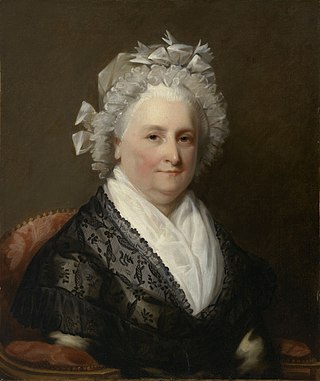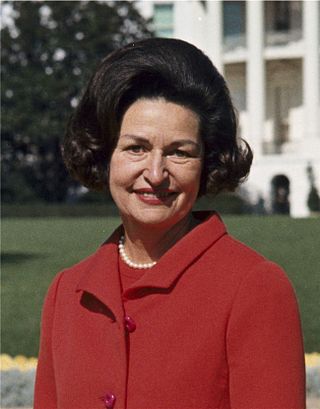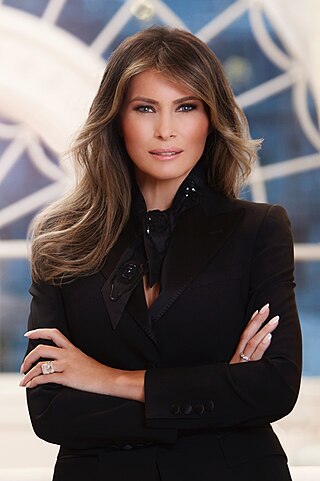
First Lady of the United States (FLOTUS) is the title held by the hostess of the White House, usually the wife of the president of the United States, concurrent with the president's term in office. Although the first lady's role has never been codified or officially defined, she figures prominently in the political and social life of the United States. Since the early 20th century, the first lady has been assisted by official staff, known as the Office of the First Lady and headquartered in the East Wing of the White House.

Nancy Davis Reagan was an American film actress and the First Lady of the United States from 1981 to 1989, as the second wife of president Ronald Reagan.

Martha Dandridge Custis Washington was the wife of George Washington, the first president of the United States. Although the title was not coined until after her death, she served as the inaugural first lady of the United States, defining the role of the president's wife and setting many precedents that future first ladies would observe. During her tenure, she was referred to as "Lady Washington". Washington is consistently ranked in the upper half of first ladies by historians.

Barbara Bush was the first lady of the United States from 1989 to 1993, as the wife of George H. W. Bush, the 41st president of the United States. She was previously the second lady of the United States from 1981 to 1989, and founded the Barbara Bush Foundation for Family Literacy. Among her children are George W. Bush, the 43rd president of the United States, and Jeb Bush, the 43rd governor of Florida. She and Abigail Adams are the only two women to be the wife of one U.S. president and the mother of another. At the time she became first lady, she was the second oldest woman to hold the position, behind only Anna Harrison, who never lived in the capital. Bush was generally popular as first lady, recognized for her apolitical grandmotherly image.

Claudia Alta "Lady Bird" Johnson was the First Lady of the United States from 1963 to 1969 as the wife of President Lyndon B. Johnson. She served as the second lady from 1961 to 1963 when her husband was vice president.

Eleanor Rosalynn Carter was an American writer, activist and humanitarian who served as the first lady of the United States from 1977 to 1981, as the wife of President Jimmy Carter. Throughout her decades of public service, she was a leading advocate for women's rights and mental health.

Elizabeth Anne Ford was the first lady of the United States from 1974 to 1977, as the wife of President Gerald Ford. As first lady, she was active in social policy and set a precedent as a politically active presidential spouse. Ford also was the second lady of the United States from 1973 to 1974 when her husband was vice president.

Thelma Catherine "Pat" Nixon was the first lady of the United States from 1969 to 1974 as the wife of President Richard Nixon. She also served as the second lady of the United States from 1953 to 1961 when her husband was vice president.

Mary Geneva "Mamie" Eisenhower was the first lady of the United States from 1953 to 1961 as the wife of President Dwight D. Eisenhower. Born in Boone, Iowa, she was raised in a wealthy household in Colorado. She married Eisenhower, then a lieutenant in the United States Army, in 1916. She kept house and served as hostess for military officers as they moved between various postings in the United States, Panama, the Philippines, and France. Their relationship was complicated by his regular absences on duty and by the death of their firstborn son at the age of three. She became a prominent figure during World War II as General Eisenhower's wife.

Helen Louise Taft, known as Nellie, was the First Lady of the United States from 1909 to 1913 as the wife of President William Howard Taft. Born to a politically well-connected Ohio family, she took an early interest in political life, deciding at the age of 17 that she wished to become first lady. Herron married Taft in 1886, and she guided him throughout his political career, encouraging him to take actions that would bring him closer to the presidency. Accompanying her husband to the Philippines in 1900, she became a prominent socialite in Manila, contributing to US-Philippines relations. After her husband was appointed Secretary of War, she played a significant role in convincing him to run for president in the 1908 presidential election and making the necessary connections to ensure his success.

Jane Means Pierce was the wife of Franklin Pierce and the first lady of the United States from 1853 to 1857. She married Franklin Pierce, then a congressman, in 1834 despite her family's misgivings. She refused to live in Washington, D.C., and in 1842, she convinced her husband to retire from politics. He sought the Democratic presidential nomination without her knowledge in 1852 and was elected president later that year. Their only surviving son, Benjamin, was killed in a train accident prior to Franklin's inauguration, sending Jane into a deep depression that would afflict her for the rest of her life. Pierce was reclusive in her role as first lady, spending the first two years of her husband's presidency in a period of mourning for her son. Her duties at this time were often fulfilled by Abby Kent-Means. After the conclusion of Franklin's presidency they traveled abroad for two years before settling in Massachusetts. She died of tuberculosis in 1863.

Margaret "Peggy" MackallTaylor was the first lady of the United States from 1849 to 1850 as the wife of President Zachary Taylor. She married Zachary in 1810 and lived as an army wife, accompanying her husband to his postings in the American frontier. She had six children, two of whom died in childhood while the remaining four were sent to boarding schools in the eastern United States. After a brief period of stable domestic life in the 1840s, her husband was elected President of the United States to her dismay in 1848. She managed the White House from the upstairs residence while she delegated her responsibilities as White House hostess to her daughter. She was highly reclusive throughout her tenure as first lady, which ended abruptly with her husband's death in 1850. She lived in obscurity until her death two years later.

Mary McElroy was an American woman known as being the sister of the 21st president of the United States, Chester A. Arthur, for whom she served as a hostess for his administration (1881–1885). She assumed the role because Arthur's wife, Ellen, had died nearly two years earlier.

Melania Trump is a Slovenian-American former model who served as the First Lady of the United States from 2017 to 2021 as the wife of President Donald Trump.

Gerald Rudolph Ford Jr. was an American politician. He was the 38th president of the United States, serving from 1974 to 1977. He previously served as the leader of the Republican Party in the U.S. House of Representatives from 1965 to 1973, and as the 40th vice president under President Richard Nixon from 1973 to 1974. Ford succeeded to the presidency when Nixon resigned in 1974, but was defeated for election to a full term in 1976. Ford is the only person to become U.S. president without winning an election for president or vice president.

Susan Elizabeth Ford Bales is an American author, photojournalist, and former chair of the board of the Betty Ford Center for alcohol and drug abuse. She is the only daughter of Gerald Ford, the 38th president of the United States and his wife Betty Ford née Bloomer.

The second gentleman or second lady of the United States is the informal title held by the spouse of the vice president of the United States, concurrent with the vice president's term of office. Coined in contrast to "first lady" – albeit used less commonly – the title "second lady" was apparently first used by Jennie Tuttle Hobart to refer to herself. The first second gentleman of the United States is Doug Emhoff, the husband of Kamala Harris, the current Vice President and first female in the position, since January 20, 2021.

On September 22, 1975, Sara Jane Moore attempted to assasinate the 38th President of the United States, Gerald Ford, after he had made an address to the World Affairs Council. Moore fired two shots at President Ford with a .38 Special revolver, both of which missed. Ford had survived a previous assassination attempt 17 days earlier, and after the second attempt President Ford would wear a bulletproof trench coat when out in public. On January 15, 1976, Moore was sentenced to life in prison for the attempt, and on December 31, 2007, was released on parole.

My Memoir is a 1938 memoir by Edith Wilson, a First Lady of the United States and the wife of Woodrow Wilson. She wrote the book as an apologia to defend her husband from perceived attacks, and to preserve his legacy. Critics generally considered the book to be "delightful" as a "collection of episodes", but especially those writing at publication predicted it would be of little historical value except for its account of Woodrow Wilson's stroke and last days in office. However it has been used by academic historians in the late 20th and early 21st centuries to examine a variety of topics related to Edith Wilson.




















